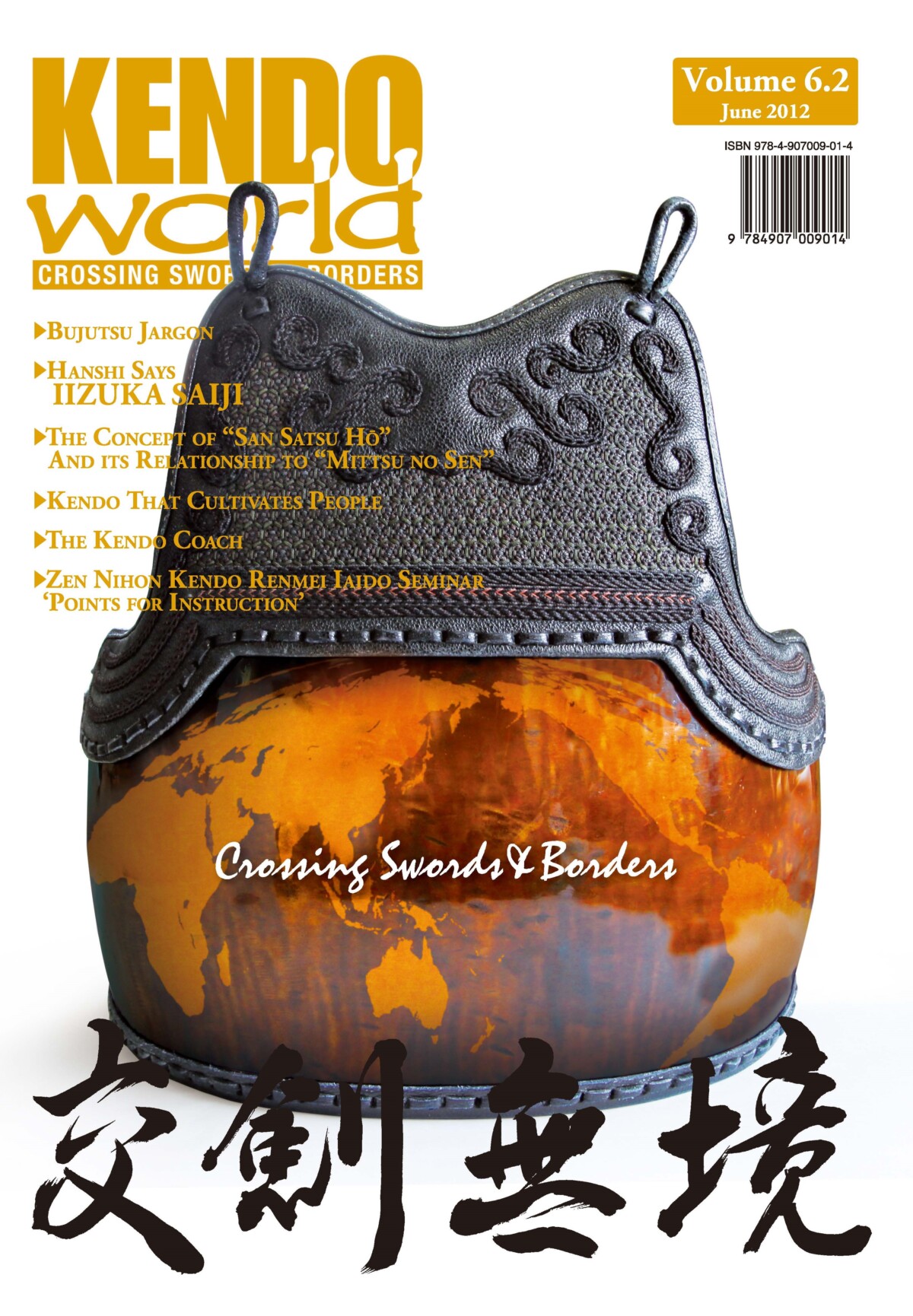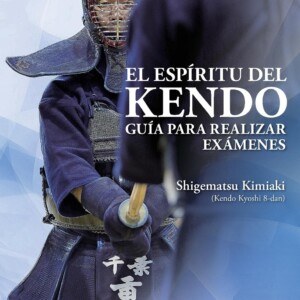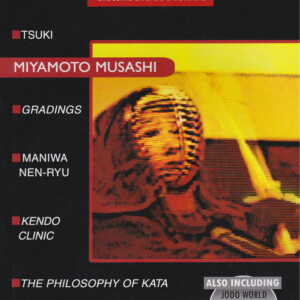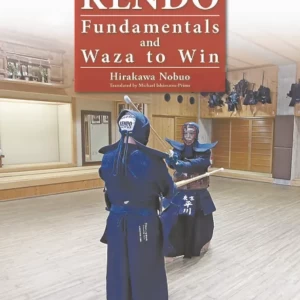
Kendo World 6.2

Editorial
By Alex Bennett PhD
First, my editorial takes a look at the recent WKC held in Novara, Italy. our tri-annual foray onto kendo’s world stage is becoming less predictable in terms of results, and which of the traditional kendo values will be tested by fire. The various incidents experienced at the recent WKC have us all questioning purported and personal kendo values. This has to be a good thing.
The Nut’s and Bolts of Kendo: What is Kyojitsu?
By Nakano Yasoji (Hanshi 9-dan)
Nakanno-sensei explains the intricacies of identifying your opponent’s mental preparedness and lapses. A vital skill for reaching the higher ranks of kendo. “If you do not take kyojitsu into consideration, the technique will not be as successful. There is kyo and jitsucontained in every movement. If you can discern this, then you will know the optimum opportunity to attack.”
Hanshi Says
Hanshi Says is a popular series in which Japan’s top Hanshi teachers give hints of what they are looking for in grading examinations based on wisdom accumulated through decades of training. This issue features Iizuka Saiji from Shizuoka. Iizuka-sensei passed the hachidan examination in 1990, and was awarded the title of Hanshi in 1999. He talks of the importance of kata, and how to focus your ki through the tip of your sword.
Watch and Learn
By Taylor Winter
KW staff writer, Taylor Winter of Otago University investigates the significance of mitori–geiko in learning kendo. Mitori–geiko is the act of looking and learning, but how exactly are your neurons stimulated through observing the keiko of others? Taylor uses his extensive knowledge of psychology to examine the benefits of proper mitori–geiko.
The Concept of “San Satsu Hō” and its Relationship to “Mittsu no Sen”
By Robert Stroud (Kendo Kyōshi 7-dan)
Robert Stroud-sensei from the US explains how the acts of “killing” the sword, “killing” the opponent’s technique, and “killing” their spirit is interconnected with timing your attack. These are complicated concepts, but fall at the very heart of kendo’s psychological and technical underpinnings. Stroud-sensei’s explanations shed light on this important area of kendo.
Kan-geiko
By Sakudō Masao (Kendo Hanshi 8-dan)
Professor Sakudō from the Osaka University of Health and Sport Science explains the importance of engaging in special training regimes such as kan–geiko. This is mid-winter training, and is conducted at the coldest time of the year in Japan to forge an indomitable body and mind. The OUHS kan–geiko is famous throughout the land. What prompted Sakudō-sensei to introduce the practice in his university, and what do kendo club members get out of it, and how is such austere training relevant to people in the modern age?
Scaling the Fourth Wall
By Michael Ishimatsu-Prime
KW senior staff writer recently passed the 4-dan examination in Japan, but the road was not easy. Michael shares his experience with us, and offers some tantalizing clues as to why he was eventually able to pass this problematic exam. What sort of mental and technical preparation is required to pass? This is a must read for people about to attempt a 4-dan shinsa.
Toshikoshi-geiko at E-BOGU’s Butokuden Dojo
By Taro Ariga (Kendo Kyōshi 7-dan)
Ariga-sensei of E-BOGU fame and longtime leader in the international kendo community introduces the history behind his business, and also the NEW Year special training which has become a fixture at his beautiful Butokuden Dojo in California.
Reidan-jichi: Kihon-dōsa
By Ōya Minoru (Kendo Kyōshi 7-dan)
Kihon-dōsa, or basic movements, refers to kamae, footwork and manipulation of the shinai. In other words, it entails all of the principles behind the striking and thrusting movements for scoring yūkō-datosu (valid attacks) in kendo. This article analyses the process of drawing and sheathing the shinai, and some finer points regarding footwork.
A Duffle Bag & a Bogu Bag – Part 8: Indiana Seminar Report
By Imafuji Masahiro (Kendo 5-dan)
Imafuji Masahiro reports on a seminar he organized for kenshi in Indiana, and its focus on understanding kendo as a life philosophy.
sWords of Wisdom
By Alex Bennett
This article introduces Miyamoto Musashi’s concept of “iwao no mi”, or “the body of a rock”.
Book Mark: “Origins of a Legend”
Reviewed by Jeff Broderick
KW staff writer Jeff Broderick reviews William De Lange’s latest translation of the Bushi Denraiki, an eighteenth century record of the life of Japan’s most famous samurai, Miyamoto Musashi.
Unlocking Japan Part 22: Reconnecting
By Lockie Jackson
Lockie Jackson’s highly acclaimed and humorous column is a kind of confession this time. Lockie talks of how he drifted away from the kendo scene as life started to get in the way. But as so many people have experienced, he found that getting back into bogu after several years off was exhilarating, and just what the doctor ordered.
A Kendo Homecoming
By Scott Huegel
A similar theme to Lockie’s “Reconnecting” article, Scott Huegel also talks of his kendo hiatus, and the unexpected return. “During that time I did not pick up a shinai, put on bōgu, or even give much of a passing thought to something that I had previously been practising for more than a decade with dedication and endeavour. Calculated out, that means kendo was not part of my life for more than 2,190 days. My hakama and keiko-gi were folded up and placed on a closet shelf. My bōgu bag sat in a corner of the garage slowly gathering dust, and not a few cobwebs…” What brought him back?
Who was this Pioneer?
By Alex Bennett
A new series by Alex Bennett, “Who was this pioneer” introduces mostly unknown but important kenshi who helped fashion the way in which kendo developed to its modern form. The first article introduces Nishikubo Hiromichi (1863-1930).
A Sterling Century of Kata
By Alex Bennett
Did you know that the Nippon Kendo Kata is exactly 100 years old this year? How and why was it created? This article outlines the process in which the Nippon Kendo Kata came to be a century ago.
Shinai Saga: “You & Me”
By Charlie Kondek
Popular kendo fiction writer, Charlie Kondek, describes the kendo journey of two young men who grow up doing kendo together. A moving story of growth and discovery through kendo in which many readers will surely be able to empathise with.
Kendo That Cultivates People
By Sumi Masatake (Hanshi 8-dan)
Sumi-sensei’s celebrated series continues. If you only view kendo as ‘sparring with bamboo sticks’, then as your physical abilities begin to decline, you are likely to completely neglect the higher principles of the art. Practitioners approaching their jukuren-ki (higher level of experience) need to bear this in mind in training, particularly those who will go on to become instructors. This instalment continues examining how high-graded and experienced practitioners should try to perform kendo and what exercises they should engage in to develop mature shinai control. It also delves into the ideal mind-set for shinpan (referees).
Bujutsu Jargon
By Bruce Flanagan MA
Bruce continues his series introducing a number of terms often encountered by people interested in Japanese history and the martial arts.
Ed’s 5-dan Grading
By Jeff Broderick
Jeff Broderick introduces jodo practitioner extraordinaire, Canadian Ed Chart. “Sitting on the floor of the dojo while awaiting his turn to challenge his 5-dan grading in March of 2012, Ed Chart looks no different than any of the other 30 or so challengers. When it is finally his turn to take the floor, he stands, takes a crutch in each hand, and moves to the far side of the dojo. Passing his crutches to a member of the grading staff, he takes up his jō, and hops over to his starting position. A murmur passes through the crowd. They have just noticed his unusual way of moving, and take a closer look. The murmur increases in volume as they realise: Ed Chart has only one leg…”
The Kendo Coach: Sports Psychology in Kendo Part 7 – Aggression in Kendo
By Blake Bennett MSS
In his previous article, an introduction to the topic of aggression in kendo training was provided based on the current literature in this field of sports research. Following on from there, starting with bullying, this article provides a further breakdown of the issues concerning aggression in kendo. Blake’s discussion focuses on the ideas of sanctioned and unsanctioned aggression, in addition to the factors of ‘player norms’, and instrumental and hostile aggression. The article will conclude with a brief overview of the physiological theories concerning aggressive behaviour, and a summary of part 1 and part 2 in this series.
Book Mark 11: “Meditations on Violence”
Reviewed by Bruce Flanagan
Brice reviews Meditations on Violence by Rory Miller – a thought-provoking nonfictional investigation into the harsh reality of various forms of physical violence and conflict and the unrealism that many practitioners of self-defence orientated martial arts are apt to succumb to in their training.
Dojo Files- Japanese Swordsmanship in Hungary
Compiled by the Budapest Főnix (Phoenix) Kendo and Iaido Club
At the 2012 15th Kendo World Championship held in Novara, Italy, the Hungarian men’s team achieved a third place victory. This success is not only the best result in Hungarian kendo history, but a wonderful present as well, as this year Hungarian kendo will celebrate its thirtieth anniversary in September! Thanks to this international success, Hungarian kendo is being noticed, but there are many stories surrounding its beginnings that few people are aware of. This essay gives us some insight into the very first men cuts in Hungary.
Kendo in Hong Kong
By Angela Chan, Carrie Au and Vivian Law (Chinese University of Hong Kong)
Kendo has become increasingly popular in Hong Kong. As of May 2012, kendo has been practised for more than forty years in Hong Kong. There are currently eight affiliated dojos and about 500 members under the Hong Kong Kendo Association. As with most of East Asia, Hong Kong was invaded by Japan in the 1940s during the Second World War, and suffered greatly under the rule of the Japanese Imperial Army. Given this history, what motivates Hong Kong people to learn kendo? This article helps us understand the present situation of kendo in Hong Kong, as well as the Hong Kong-Japanese relationship.
Dojo Files- The World’s Southernmost Kendo Club Turns 10
By Shane Robinson and Dave Rogers
Every heard of a little town called Invercargill? No? Maybe you have seen the movie starring Anthony Hopkins called “The world’s fastest Indian”. Invercargill is situated at the very bottom of the South Island of New Zealand. This makes the kendo club there, the southernmost in the world. They are celebrating their tenth birthday this year.
The History of Kendo in France
By Tanguy L’Aminot; Translated by Baptiste Tavernier
France is one of the European powerhouses in kendo. This article on the history of kendo in France was written almost twenty years ago by Tanguy L’Aminot. It covers a period ranging from the 1950s until the late 1980s, and focusses on the events that shaped kendo in France in its formative years. It is a must-read for those interested in how kendo has taken shape in the West.
Barefoot Kendo
By Hamish Robison
“Why don’t you wear shoes?” is a question we hear quite often from people who see kendo for the first time. An increasing number of runners are also hearing this question, thanks to the increase in popularity of barefoot running. There seem to be a number of parallels between kendo and the principles of barefoot running, and in this article Kendo World co-founder, Hamish Robison, does a brief comparison of the two.
Redressing Old Wounds: American Filmmakers Hope to Return a War Sword
By Tyler Rothmar
As the 67th anniversary of Japan’s surrender nears, a small film crew in America is in the process of documenting what they hope will be a potent gesture: the search for the owner of a Japanese sword taken to the U.S. after WWII, in the hope of returning it. “It all started with this random sword, and then turned into something else entirely,” says Forgive–Don’t Forget’s producer, Brad Bennett of Shaking Hands Productions. Tyler Rothmar interviews Brad to find out more about this fascinating project.
Kyoto Taikai 2012
By Jeff Broderick
Jeff introduces some of the highlights at this year’s famous Kyoto Taikai.
Zen Nihon Kendo Renmei Iaido Seminar ‘Points for Instruction’
By Hamish Robison and Kaneda Kazuhisa (Iaido Kyōshi 8-dan)
At a recent seminar in Japan, some aspects of the All Japan Kendo Federation Seitei Iai kata were clarified in more detail. KW asked 8-time All Japan Iaido Champion and International Budo University Iaido teacher, Kaneda Kazuhisa-sensei (Iaido K8-dan) to act as our model to explain some of the finer points of an instructional document provided by the Kendo Federation’s Iaido division.
AVAILABLE IN PRINT AND KINDLE VERSIONS AND ON THE BUDO BOOKS APP IN E-BOOK FORMAT! SEE THE LINKS BELOW!!
























No comments yet.